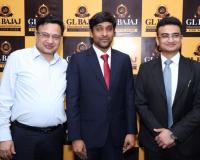Understanding ACL Injuries, Get Expert’s Perspective

Jaipur (Rajasthan) [India], August 20: Dr Naveen Sharma, an ACL specialist trained in Mumbai, Germany, and South Korea, sheds light on the intricacies of anterior cruciate ligament (ACL) injuries and their treatment. With his extensive experience, Dr Sharma offers valuable insights into this common knee injury that affects many athletes and active individuals.
The ACL is one of four cruciate ligaments in the knee joint, connecting the femur (thighbone) to the tibia (shinbone). Dr Naveen Sharma explains, “All these four ligaments are very important for the knee joint as these ligaments help us in running and sports and connect upper bone with lower bone.”
ACL injuries often occur during high-impact activities or sports such as kabaddi, cricket, and various jumping sports. Dr Sharma notes, “As soon as a person injures his ACL, he feels severe pain and swelling can occur, which can be treated with ice and medicines. The patient may feel better in a few days.”
However, the true extent of the injury may take time to be apparent. Dr Sharma cautions, “You may miss an ACL sometimes if you just do x-rays. If the patient does not feel better with drugs and feels like he cannot run or may fall while running, the doctor may advise going for magnetic resonance imaging or MRI.”
The severity of ACL tears is graded from 1 to 3, with grade 3 indicating a complete tear. For young, active individuals with complete tears, Dr Sharma strongly recommends surgical intervention. He states, “For youngsters, my advice is that they should get ACL reconstruction surgery at the right time.”
Addressing concerns about long-term effects, Dr Sharma reassures, “I want to assure you that ACL ligament surgery is very successful, and it is done with arthroscopy. Arthroscopy is an advanced technique; the advantage of this technique is it is done with the help of a camera.”
Post-surgery rehabilitation is crucial for a full recovery. Patients usually begin walking with support within 24 hours and can gradually increase weight-bearing over the following weeks. Physical therapy can aid recovery, and most patients resume normal activities within several months. Dr. Sharma recommends using a knee brace for six weeks for added protection.
Post-surgery rehabilitation is crucial for a full recovery. Dr Sharma outlines the process, saying, “24 hours after surgery, the patient is allowed to walk with the support of a walker. After two weeks, suture removal can be done, and some simple exercises can be started, which a patient can do at home easily.”
For athletes eager to return to their sport, Dr Sharma advises patience. “Running fast is allowed after 8 to 9 months. If I come across athletes or players, they can do games after 9 to 12 months,” he explains.
Dr Sharma emphasizes that non-surgical treatments are ineffective for ACL tears in young, active individuals. He firmly states, “Many people asked me questions like, can we treat an ACL tear with physiotherapy, medicines, or injections? I would say no, never! Physiotherapy can improve muscle strength, but a broken ligament will not heal with exercises.”
However, he does acknowledge that non-surgical approaches might be considered for older, less active individuals. “If you are older than 55 or 60, then try physio, injection, or other medicines,” Dr Sharma suggests.
Through his expertise and clear explanations, Dr Naveen Sharma provides valuable guidance for those dealing with ACL injuries, helping patients make informed decisions about their treatment options. At present, he has a top-rated YouTube channel for assisting ACL patients. His channel name is ‘Dr Naveen SHARMA’s Knee and Shoulder Clinic.’ His hospital is located in Jaipur. For consultation, please contact him on 8209830287.
Disclaimer: The article is for general information purposes only and should not be construed as professional medical advice. Always consult your doctor before taking any step.






